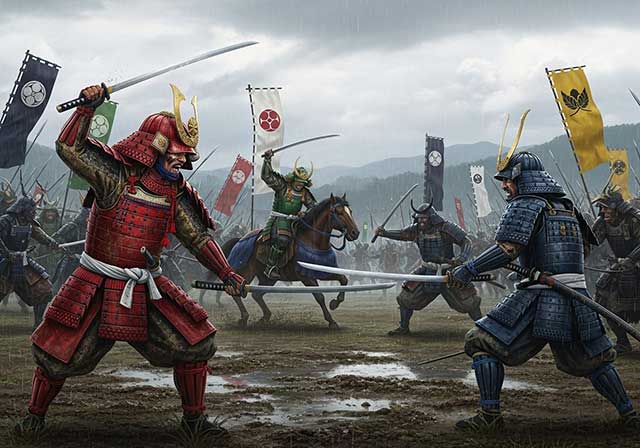
In August 1547, luck smiled on Oda Nobuhide—thanks to a secret agreement, he managed to capture the five-year-old son of the head of the Matsudaira clan, the future Tokugawa Ieyasu. The boy's father, Matsudaira Hirotada, was gradually leaning towards an alliance with the Imagawa clan and, as a guarantee, was obliged to send his heir as a hostage. However, Oda Nobuhide managed to negotiate with the local commander accompanying the child, and for a reward, he handed Hirotada's son over to Nobuhide.
Having received such a valuable hostage, Nobuhide presented Hirotada with an ultimatum. But Ieyasu's father, bound by a treaty with the Imagawa, refused to accept the terms, stating that for the sake of his clan's interests, he was willing to sacrifice even the life of his own young son. Some historians suggest that Hirotada also believed that a living Ieyasu would be more useful to Oda than a dead child. The blackmail was unsuccessful, and Nobuhide decided to give the boy to one of his vassals to raise, thus saving the life of the future founder of the Tokugawa dynasty.
In October 1547, a schism broke out within the Matsudaira clan, which Nobuhide took advantage of. Joining forces with Matsudaira Tadamichi, who had opposed the clan leader, he attempted to capture Okazaki Castle, the main stronghold of the Matsudaira family. However, the defenders managed to repel the attack with great difficulty. After that, Hirotada was forced to seek help from Imagawa Yoshimoto. Receiving reinforcements under the command of the monk Taigen Sessai, Hirotada headed for Anjo Fort, which had been taken from him in 1540.
The battle began with an ambush on Oda's troops and went down in history as the Second Battle of Azukizaka. Despite fierce resistance, Nobuhide was defeated and lost Anjo Fort. Nobunaga's family chronicle, Shintō Kōki, states that in this battle, Nobuhide's poorly organized crowd of warriors clashed with the Imagawa's echeloned formation of foot soldiers, armed with long spears and lined up in seven rows, and was crushed by them.
After analyzing the outcome of the battle, Oda Nobuhide decided to stop fighting on two fronts at once. In the fall of 1548, he concluded a peace agreement with Saito Dosan and exchanged Matsudaira Motoyasu for the lost Anjo Fort.
Having closed the western front, Nobuhide was able to concentrate his forces on the eastern direction. According to one version, in February 1549, he sent a shinobi who killed the 22-year-old Matsudaira Hirotada. However, Nobuhide did not have time to take advantage of the results of this operation, as Imagawa Yoshimoto established control over key forts in the eastern and central parts of Mikawa Province.
See also
-
The Siege of Hara Castle

The Shimabara Rebellion of 1637–1638, which culminated in the siege of Hara Castle, was the last major uprising of the Edo period and had serious political consequences.
-
Battle of Tennoji

The confrontation between Tokugawa Ieyasu and Toyotomi Hideyori during the “Osaka Winter Campaign” ended with the signing of a peace treaty. On January 22, 1615, the day after the treaty was signed, Ieyasu pretended to disband his army. In reality, this meant that the Shimazu forces withdrew to the nearest port. On the same day, almost the entire Tokugawa army began filling in the outer moat.
-
Siege of Shuri Castle

The Ryukyu Kingdom was established in 1429 on Okinawa, the largest island of the Ryukyu (Nansei) archipelago, as a result of the military unification of three rival kingdoms. In the following years, the state's control spread to all the islands of the archipelago.
-
The Siege of Fushimi Castle

Fushimi can perhaps be considered one of the most “unfortunate” castles of the Sengoku Jidai period. The original castle was built by Toyotomi Hideyoshi in the southeast of Kyoto in 1594 as his residence in the imperial city.
-
The Siege of Otsu Castle

The siege of Otsu Castle was part of the Sekigahara campaign, during which the so-called Eastern Coalition, led by Tokugawa Ieyasu, fought against the Western Coalition, led by Ishida Mitsunari. Otsu Castle was built in 1586 by order of Toyotomi Hideyoshi near the capital Kyoto, on the site of the dismantled Sakamoto Castle. It belonged to the type of “water castles” — mizujō — as one side of it faced Japan's largest lake, Lake Biwa, and it was surrounded by a system of moats filled with lake water, which made the fortress resemble an island.
-
The Siege of Shiroishi Castle

The siege of Shiroishi Castle was part of the Sekigahara campaign and took place several months before the decisive battle of Sekigahara. The daimyo of Aizu Province, Uesugi Kagekatsu, posed a serious threat to Tokugawa Ieyasu's plans to defeat the Western Coalition, and Ieyasu decided to curb his actions with the help of his northern vassals. To this end, he ordered Date Masamune to invade the province of Aizu and capture Shiroishi Castle.
-
The Second Siege of Jinju Castle

During the two Korean campaigns of the 16th century, the Japanese repeatedly had to capture enemy fortresses and defend occupied or constructed fortifications from the combined Korean and Chinese forces. Among all the operations of that time, the second siege of Jinju Castle is considered the most interesting from the point of view of siege warfare.
-
The Siege of Takamatsu Castle

The siege of Takamatsu Castle in Bitchu Province is considered the first mizuzeme, or “water siege,” in Japanese history. Until then, such an original tactic had never been used.

